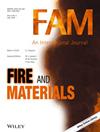Experimental Studies of the Effects of Recoating on Fire Protection Properties of Old and New Layers of Intumescent Coatings for Steel Elements
Abstract
This paper presents the results of experimental studies investigating the effects of recoating on fire protection properties of composite layers of intumescent coatings for steel elements. Intumescent coatings, both with and without topcoats, were applied to steel plates. The samples were subjected to different cycles of hydrothermal aging before recoating. The composite layers of the existing and new coatings were then tested under fire. Comparisons of the morphological structures of the carbonaceous char revealed that the existing coating had little effect on the expansion properties of the new coating. However, the new coating reduced the expansion ratio of the existing coating. The thermal resistance of the existing coating decreased with the increasing thickness of the new coating. For specimens with a new coating 1.0 mm thick, the thermal resistance of the existing coating, after even moderate environmental exposure, was < 20% of the total and can be ignored. Contributions from the existing coating may be considered when specifying the thickness of the new coating if the new coating thickness is small and the existing coating is subjected to moderate environmental aging. Recoating with a different type of intumescent coating from the existing one appeared to provide better fire protection performance than using the same type.

 求助内容:
求助内容: 应助结果提醒方式:
应助结果提醒方式:


